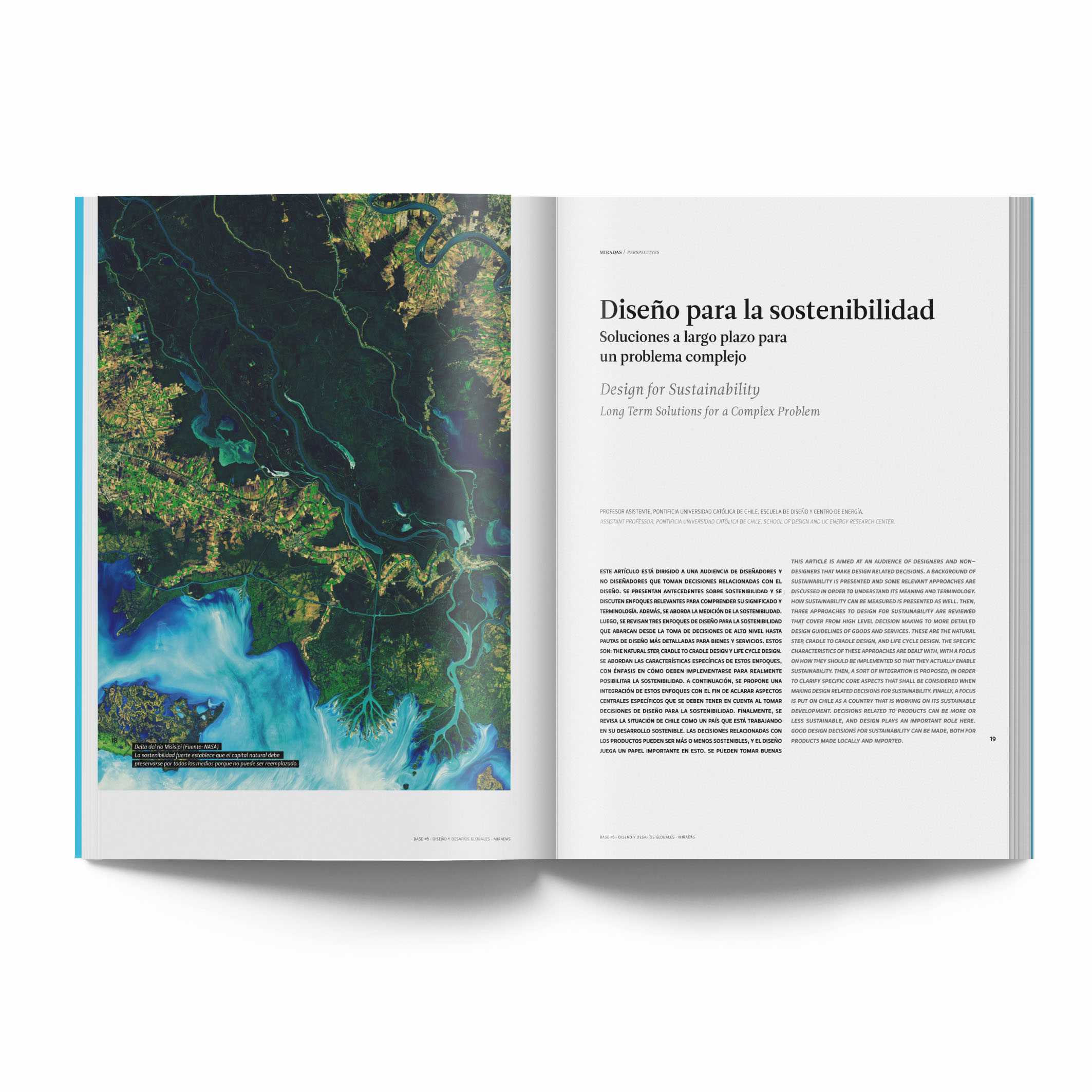Design for Sustainability Long Term Solutions for a Complex Problem
Main Article Content
Abstract
This article is aimed at an audience of designers and non-designers that make design related decisions. A background of sustainability is presented and some relevant approaches are discussed in order to understand its meaning and terminology. How sustainability can be measured is presented as well. Then, three approaches to design for sustainability are reviewed that cover from high level decision making to more detailed design guidelines of goods and services. These are The Natural Step, Cradle to Cradle Design, and Life Cycle Design. The specific characteristics of these approaches are dealt with, with a focus on how they should be implemented so that they actually enable sustainability. Then, a sort of integration is proposed, in order to clarify specific core aspects that shall be considered when making design related decisions for sustainability. Finally, a focus is put on Chile as a country that is working on its sustainable development. Decisions related to products can be more or less sustainable, and design plays an important role here. Good design decisions for sustainability can be made, both for products made locally and imported.
Article Details
References
Anderson, R., & White, R. (2010). Business lessons from a radical industrialist. New York: St. Martin's Griffin.
Azar, C., Holmberg, J., & Lindgren, K. (1996). Socio-ecological indicators for sustainability. Ecological economics, (18), 89-112.
Barbier, E.B. (1994). Valuing environmental functions: tropical wetlands. Land Economics, pp. 155-173. University of Wisconsin Press. Retrieved on March 30, 2021 from https://www.jstor.org/stable/3146319.
Braungart, M., McDonough, W., & Bollinger, A. (2007). Cradle-to-cradle design: creating healthy emissions - a strategy for eco-effective product and system design. Journal of Cleaner Production, 15, 1337-1348.
Daly, H. E., & Farley, J. (2011). Ecological economics principles and applications. NW Washington, DC: Island Press.
Dietz, S., & Neumayer, E. (2007). Weak and strong sustainability in the SEEA: concepts and measurement. Ecological Economics, (61), 617-626. DOI: 10.1016/j.ecolecon.2006.09.007.
Elkington, J. (2004). Enter the triple bottom line. In A. Henriques & J. Richardson (Eds.), The triple bottom line: does it all add up? (pp. 1-16). Retrieved from: http://www.johnelkington.com/TBL-elkington-chapter.pdf
Goodland, R. (1995). The Concept of environmental sustainability. Annual Review of Ecology and Systematics, 26, 1-24.
Hawken, P. (2010). The ecology of commerce. (Revised ed.). New York, NY: Harper-Collins Publishers.
Huerta, O. (2014). Integrating environmentally responsible design with life cycle assessment in product and process development for sustainability. (Order No. 3619907, Arizona State University). ProQuest Dissertations and Theses, 238. Retrieved from http://search.proquest.com/docview/1537054306?accountid=35915. (1537054306).
Huerta, O. (2020). Ecodiseño de envases para una economía circular. RChD: creación y pensamiento, 5(9), 1. https://doi.org/10.5354/0719-837X.2020.58303
Keoleian, G. A., Menerey, D., & Curran, M. A. U.S. Environmental Protection Agency, Risk Reduction Engineering Lab. (1993). Life cycle design guidance manual: environmental requirements and the product system (EPA/600/R-92/226). Retrieved from U.S. Environmental Protection Agency website: http://nepis.epa.gov/Exe/ZyPURL.cgi?Dockey=30002PR5.txt
Neumayer, E. (2003). Weak versus strong sustainability: exploring the limits of two opposing paradigms. Second edition. Northampton: MA. Edward Elgar Publishing Limited.
OECD/ECLAC (2006). Nature Conservation and Biodiversity, in OECD Environmental Performance Reviews: Chile 2005, OECD Publishing. http://dx.doi.org/10.1787/9789264009684-5-en
OECD (2010). Agreement on the terms of accession of the Republic of Chile to the convention on the organisation for economic co-operation and development. OECD Publishing. Retrieved from: https://www.oecd.org/chile/chilesaccessiontotheoecd.htm
Robèrt, K. H. (2002). The natural step story: Seeding a quiet revolution. Gabriola Island, Canada: New Society Publishers.
United Nations (UN, 1987). Our Common Future, Chapter 2: Towards Sustainable Development. Report of the World Commission on Environment and Development.
United Nations Environment Programme (2011). Towards a life cycle sustainability assessment: making informed choices on products. ISBN: 978-92-807-3175-0
Zamagni, A., Pesonen, H. & Swarr, T. (2013). From LCA to Life Cycle Sustainability Assessment: concept, practice and future directions. International Journal of Life Cycle Assessment 18, 1637–1641. doi:10.1007/s11367-013-0648-3
White, P., St. Pierre, L. & Belletire, S. (2013). Okala Practitioner: Integrating ecological design. Portland, OR: IDSA.


